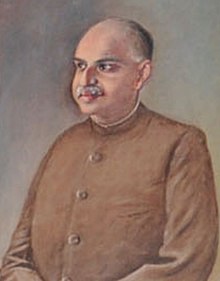
Back سياما براساد موخيرجي Arabic سياما پراساد موكيرچى ARZ শ্যামাপ্রসাদ মুখোপাধ্যায় Bengali/Bangla Syama Prasad Mukherjee German Syama Prasad Mukherjee Spanish Syama Prasad Mukherjee French סיאמה פרסד מוקהרג'י HE श्यामाप्रसाद मुखर्जी Hindi Շյամա Պրասադ Մուկերջի Armenian Syama Prasad Mukherjee ID
Syama Prasad Mukherjee | |
|---|---|
| শ্যামাপ্রসাদ মুখোপাধ্যায় | |
 | |
| Member of Parliament, Lok Sabha | |
| In office 17 April 1952 – 23 June 1953 | |
| Succeeded by | Sadhan Gupta |
| Constituency | Calcutta South East |
| Minister of Commerce and Industry of India | |
| In office 15 August 1947 – 6 April 1950 | |
| Prime Minister | Jawaharlal Nehru |
| Preceded by | Position established |
| Succeeded by | Nityanand Kanungo |
| Member of the Constituent Assembly | |
| In office 9 December 1946 – 24 January 1950 | |
| Constituency | West Bengal |
| Founder-President of the Bharatiya Jana Sangh | |
| In office 1951–1952 | |
| Preceded by | Position established |
| Succeeded by | Mauli Chandra Sharma |
| Finance Minister of Bengal Province | |
| In office 12 December 1941 – 20 November 1942 | |
| Prime Minister | A. K. Fazlul Haq |
| Member of the Bengal Legislative Council | |
| In office 1929–1947[1] | |
| Constituency | Calcutta University |
| Vice-Chancellor of Calcutta University | |
| In office 8 August 1934 – 8 August 1938[2] | |
| Preceded by | Hassan Suhrawardy |
| Succeeded by | Muhammad Azizul Haque |
| President of Akhil Bhartiya Hindu Mahasabha | |
| In office 1943–1947 | |
| Personal details | |
| Born | 6 July 1901 Calcutta, Bengal Presidency, British India (present-day Kolkata, West Bengal, India) |
| Died | 23 June 1953 (aged 51) Srinagar, Jammu and Kashmir, India |
| Political party | Bharatiya Jana Sangh |
| Spouse | Sudha Devi |
| Children | 5 |
| Parent(s) | Ashutosh Mukherjee (father) Jogamaya Devi Mukherjee (mother) |
| Relatives | Chittatosh Mookerjee (nephew) |
| Alma mater | Presidency College (B.A., M.A., LLB, D.Litt.) Lincoln's Inn (Barrister-at-Law) |
| Profession | |
| Signature | |
Syama Prasad Mukherjee (6 July 1901 – 23 June 1953) was an Indian politician, barrister and academician, who served as India's first Minister for Industry and Supply (currently known as Minister of Commerce and Industries) in Prime Minister Jawaharlal Nehru's cabinet. After falling out with Nehru,[3] protesting against the Liaquat–Nehru Pact, Mukherjee resigned from Nehru's cabinet.[4] With the help of the Rashtriya Swayamsevak Sangh,[citation needed] he founded the Bharatiya Jana Sangh, the predecessor to the Bharatiya Janata Party, in 1951.[5]
He was also the president of Akhil Bharatiya Hindu Mahasabha from 1943 to 1946. He was arrested by the Jammu and Kashmir Police in 1953 when he tried to cross the border of the state. He was provisionally diagnosed of a heart attack and shifted to a hospital but died a day later.[6][7] Since the Bharatiya Janata Party is the successor to the Bharatiya Jana Sangh, Mukherjee is also regarded as the founder of the Bharatiya Janata Party (BJP) by its members.[8]
Dr Mukherjee was inspired by the ideologies of Swami Pranavananda, founder of Bharat Sevashram Sangha and considered him as his guru.
- ^ Mishra 2004, p. 96.
- ^ "Our Vice-Chancellors". University of Calcutta. Archived from the original on 1 January 2020. Retrieved 1 December 2016.
- ^ Kingshuk Nag (18 November 2015). Netaji: Living Dangerously. AuthorsUpFront | Paranjoy. pp. 53–. ISBN 978-93-84439-70-5.
- ^ "Dr. Shyama Prasad Mookerjee". www.shyamaprasad.org. Archived from the original on 21 July 2022. Retrieved 1 June 2019.
- ^ "Bharatiya Jana Sangh | Indian political organization". Encyclopædia Britannica. Archived from the original on 20 February 2023. Retrieved 1 June 2019.
- ^ Bakshi 1991, pp. 278–306.
- ^ Smith 2015, p. 87.
- ^ "History of the Party". www.bjp.org. Archived from the original on 12 August 2021. Retrieved 6 August 2019.
© MMXXIII Rich X Search. We shall prevail. All rights reserved. Rich X Search